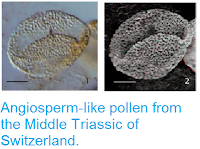Pollen is extremely useful to archaeologists and palaeontologists. It is
resilient both and distinctive, and plants produce it in large amounts,
and scatter it freely in the environment. Scientists who study pollen,
called palynologists, are able to use pollen to date ancient sediments
and to reconstruct the vegetation, and therefore climate, of ancient
sites.
The Shahezi Formation is a coal-bearing Cretaceous sedimentary sequence from the Songliao Basin of northeast China. It comprises two components, a lower member composed of tuff and tuffaceous mudstone, and an upper member composed of mudstone, siltstone, conglomerate and coal, and is considired important for both its (economically useful) coal, and its potential insights into the evolution of the Songliao Basin, and geological events related to the carbon cycle and greenhouse climate change during the Early Cretaceous. However, It is is difficult to differentiate the Shahezi Formation from other coal-bearing strata in the region, such as the Jehol Biota-producing Yingcheng Formation, on lithology alone, which hampers the study of this formation, and therefore limits its usefulness.
In a paper published in the journal Acta Geological Sinica on 27 February 2018, Wang Chenglong and Zhang Meisheng of the College of Earth Sciences at Jilin University, Liu Xuesong, also of the College of Earth Sciences, and of the Museum of Geology at Jilin University, and Sun Kai of the Exploration and Development Research Institute of Jilin Oilfield Company, present the results of a palynological study of the Shahezi Formation, which appears to be able to differentiate it from other coal-bearing formations in the region.
Wang et al. collected six samples for analysis from the Shahezi Coal Mine in Changtu County, the type locality for the Shahezi Formation, five of which were found to contain palynological fossils, once treated with hydrochloric and hydrofluoric acid to remove carbonates and silicates, respectively.
The samples were found to contain between 71.43% and 84.48% Gymnosperm pollen, dominated by Perinopollenites, (13.39%−18.97%), Taxodiaceaepollenites (7.14%−10.17%), and Abietineaepollenites (6.78% −12.07% ), and between 15.52% and 28.57% Pteridophyte spores, dominated by Granulatisporites (1.72% −6.25% ), Polypodiaceaesporites (1.72%−5.36%), and Cyathidites (1.69% −5.17% ).
Typical palynological fossils from the Shahezi Formation in the Shahezi Coal Mine. (1), Cyathidites; (2), Baculatisporites; (3), Cicatricosisporites; (4), Granulatisporites; (5), Polypodiaceaesporites; (6), Schizosporis; (7), Inaperturopllenites; (8), Pinuspollenites; (9), Concentrisporites; (10), Taxodiaceaepollenites; (11), Abietineaepollenites; (12), Cycadopites; (13), Perinopollenites; (14), Paleoconiferus. Wang et al. (2018).
The samples did not contain any Angiosperm pollen, which is found in the Yingcheng Formation, nor warm-climate adapted Fern spores such as Ruffordia and Coniopteris, which dominate the Yingcheng Formation, allowing differentiation of the two formations.
See also...
Follow Sciency Thoughts on Facebook.





